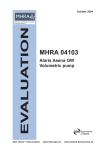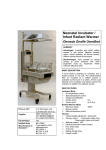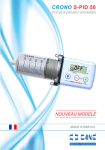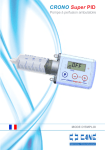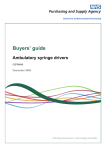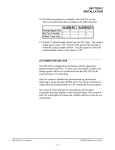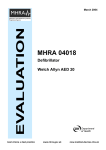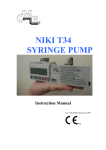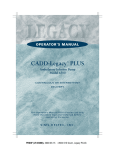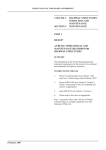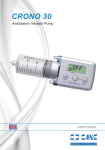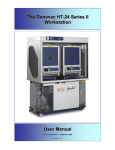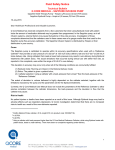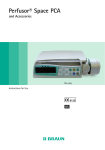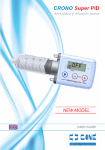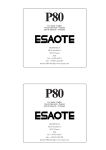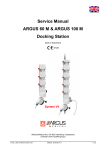Download evaluation - MedTecShop
Transcript
April 2004 evaluation NUMBER 03141 Syringe Pump Codan green stream® SY-P ARGUS 600 D MAIN FEATURES Power supply Advantages: Docking station offers barcoding (matches patient with drug) and single cable mounting for up to 5 pumps. Good long term accuracy. Good start up time. Good resistance to dislodging of syringe. Low profile, several pumps can be mounted on one pole. Highly configurable (but see disadvantages below). Disadvantages: Display is limited in amount of information displayed. Poor short term accuracy. Multi-function key and configuration options/codes are potentially confusing. Patient weight dependent dosing requires purchase of docking station. Faults during testing: Faulty battery. evaluation 03141 SUMMARY The Codan green stream® SY-P ARGUS 600 D is a simple syringe pump designed for general purpose use, and as such has largely appropriate functionality and performance. Codan also market the pump for Intensive Care use. Evaluation shows that the short term accuracy should elicit caution when selecting the pump for use with short half life drugs at very low flow rates. The pump also lacks some of the features that are now routinely present on syringe pumps used in ICU. A docking station is available offering additional functionality including a bar coding facility for matching patient and drug. This is an excellent safety feature Evaluation showed the technical performance of the syringe pump was satisfactory (with above mentioned caveat about low flow rates); whilst the user interface was found to have some drawbacks. Display limitations, for instance, can necessitate scrolling through © crown copyright Syringes accepted (list not exhaustive) Extension set Flow rate range 230 VAC 50/60 Hz; internal rechargeable battery Codan, B-D Plastipak, Monoject, Terumo, Braun 10 - 60ml syringes Codan (or any standard line) 0.1 - 999.9 ml/h Occlusion detection Drive force sensor. 150 900 mmHg configurable pressure. Graphical pressure display Alarms and alerts Comprehensive, though lacking clarity and specificity in some areas. SUMMARY (continued) parameters to set up or control infusions. For simple infusions, however, the pump is easy to use. The pump has many configurable options, governing both advanced features and basic operation. An event log is provided. A serial communications port allows download of the event log and down/upload of configuration. Price (ex VAT) £1450 List price Manufacturer Argus Medical AG, Aarestrasse 13, CH-362 Heimberg, Switzerland CE Marking Yes, MD Directive Notified Body SGS UNITED KINGDOM LIMITED (0120) Certified to Standard? EN 60601-(1, 1-2, 1-4, 2-24) EN 61000-4-(2,3,4,5,6,7,11) EN 55011 £ 36 (Free to the NHS) Description 1 2 7 3 8 4 9 5 10 11 6 12 13 15 14 16 Figure 1. Front view of pump KEY 1 Operation Mode Indicator 11 Bolus/Prime key 2 Infusion Rate Display 13 Syringe ear guide 3 Infusion Volumes display 14 Drive head 4 Pressure display 15 Syringe plunger retaining flippers 5 Alarm indicator 16 Clutch lever 6 Alarm cause indicator 17 Pole clamp 7 On/off key 18 Interface (for RS232 or External 12V DC) 8 Rate keys 19 Equipotential plug 9 MODE key 20 Staff alert socket 10 Start/stop key 21 AC power socket 12 Syringe barrel holder 17 19 20 21 18 Figure 2. Rear view of pump MHRA evaluation 03141, April 2004 2 CODAN green stream® SY-P ARGUS 600 D Description CONTENTS Page Description Ergonomic Assessment User Assessment Technical Assessment Manufacturer’s Comments Methodology Manufacturer’s Data User Assessment Questionnaire About MHRA reports 3 3 7 8 12 13 14 16 20 illustrated. (17) Horizontal rail clamps of various sizes are available as accessories. Also provided on the back of the pump are: an interface for RS232 communications or connection to an external 12V DC power supply (18), an equipotential plug (19), a socket for a nurse call system (20) and a mains power input socket (21). Stacking: Argus 600 syringe pumps can be stacked in close proximity to one another on a pole, and a docking station is also available which allows power and communication with up to five pumps. DESCRIPTION Reference is made to the Photographs (Figures 1 and 2 on page 2) Interference: The pump complies with IEC 60601-1-2. The manufacturer makes no additional claims for this pump regarding electromagnetic compatibility (EMC) or suitability for use in MRI rooms. The operation mode indicator (1) uses icons to display the pump's current power source (Mains or battery) and also to show if the pump is infusing or is delivering in KVO (keep vein open) mode. One LED display (2) shows set flow rate, and another (3) displays volume infused (or other parameters, dependent on the configuration). This icon is labelled ml inf. If reconfigured to display “volume remaining to be infused” confusion can be caused, as the label remains as “ml inf”. The default configuration of the pump ensures that function and label correspond. BIME Note: Configurability will be discussed later in this report; in general however, caution needs to be applied in changing any aspect of the configuration of this pump, as discrepancy between actual function and expected function of keys can be generated. Costs: The list price for the pump is £1450. The user manual states that the pump has been optimised for use with CODAN syringes. The list price for Codan 50/60ml syringes is £0.29 (minimum order 300 units). The list price for the Codan extension sets used in this evaluation (part no. 71.4349) is £0.60 (box size = 100). All prices exclude VAT. ERGONOMIC ASSESSMENT The Codan green stream® SY-P ARGUS 600 D is a syringe pump targeted at general ward use. Users intending to purchase the SY-P 600D for Intensive Care use might also consider purchasing the docking station QUICK® 100M whose added functionality includes patient weight dependent dosing and bar-code matching of patient and drug. The remaining LED displays are all alarm indicators. These comprise a bar graph showing estimated line pressure changes (4), a large indicator to show that an alarm has been triggered (5) and a further smaller indicator to specify the alarm cause (6). Format: Size is typical and weight above average for a modern ward based syringe pump (2.9 Kg, 30 x 10 x 20 cm). The optional short life battery (2.5 hours) can reduce the weight by 0.6 Kg. The front panel controls comprise eight keys in a horizontal line. There is a single key to turn the pump on or off (7), four keys to set flow rate (8), a MODE key which has several functions (9), a single key to start or stop the pump (10), and a single key to prime the line or deliver a bolus (11). The pump can be used on a bench or mounted on a vertical pole or horizontal pole. The syringe is held horizontally and fluid is delivered from right to left, as is typical, thus promoting intuitive handling and syringe loading. The lack of integral carry handle can make the pump a little unwieldy to hold. An optional pole clamp with carry handle can be purchased to alleviate this problem although this prevents stacking in the docking station. The shape of the top surface of the pump casing facilitates holding the pump in one hand. A syringe is loaded horizontally on the front of the pump. It is supported by a barrel clamp (12), a syringe ear guide (13) and syringe plunger retaining flippers (15) on the drive head (14). The drive head is positioned and its flippers are opened to accept the syringe, by using the clutch lever (16). There is a pole clamp provided on the back of the pump - the standard stackable version is CODAN green stream® SY-P ARGUS 600 D The standard pole clamp is straightforward to use. 3 MHRA evaluation 03141, April 2004 Ergonomic Assessment Other pole clamp options facilitate fixing the pump to horizontal rails of various sizes. These were not assessed during this evaluation. functions. As with all current infusion technology, the pump should not be used without training being completed and competence assessed. The pump is normally powered by a standard external AC source (230 VAC +10/-15%, 50 - 60 Hz, 9 Watt). An external DC power source can also be used. In the absence or failure of external power, an internal sealed lead acid battery automatically takes over the supply. No audible signal is given if this occurs. The cable connects into the back of the pump but is not “captive” and in theory can be accidentally dislodged, although this did not occur during the period of evaluation. BIME Note: A captive cable prevents accidental dislodging, however it could also have the drawbacks that a) the infusion pole may be pulled over, and b) the cable itself can cause an unnecessary trip hazard whilst transporting the equipment, or using it on battery. Audible signals are clear and appropriate. Volume can be adjusted in five steps but cannot be turned off. Loading the syringe: Loading the syringe is easy except when the pump is on the bench - a bench support can be obtained as an accessory to make this easier. The syringe is loaded behind the barrel retaining clamp, the ears located in the slot provided and the plunger gripped by positioning of the flippers. It was found during evaluation that the flippers that hold the plunger head performed adequately except when a 50 ml BD Plastipak was in use, frequently failing to secure this type of syringe satisfactorily. (Codan recommends the use of Codan syringes). Failure to grip the syringe invariably caused alarm, as did failure to engage either the barrel or ear detectors. The same alarm is activated for both syringe absence and misload - most current pumps provide individual alarms to indicate which clamping part is at fault. A docking station is available for the pump, allowing single cable powering of up to five pumps which presents a significant ergonomic advantage. The docking station was not provided for evaluation. Dependent on the size of syringe in use, the plunger driver is mostly contained within the profile of the pump, but can extend slightly beyond the pump casing when a syringe is filled with more than 47 ml of fluid. This common feature of several current syringe pumps leaves the drive mechanism hypothetically more vulnerable to damage if the pump is dropped. If the pump is started with the syringe misloaded and without first operating the prime function, then alarm due to syringe ear mispositioning can be slow to occur. Up to two minutes may pass before the fault is registered with smaller syringes (10ml - 30ml). Syphoning is likely to be prevented in this case by the barrel clamp. The above scenario involves a double user error - misloading syringe and failing to use the prime function. It is not possible to start the pump with the barrel clamp disengaged. User Interface: All displays are well lit, clear to view and appropriately angled for reading at a range of heights. They convey limited information to the user, however, which sometimes necessitates multi-step programming operations that can become confusing. Supplementary information is provided by the fluid management system display that will be supplied in future as part of the docking station, but this is not yet available in the UK. In testing, the pump showed a good ability to resist dislodging of the syringe (see page 12 of this report). Priming: The operations manual advocates priming the syringe in the pump prior to starting an infusion but does not state the consequences of not priming. The danger of priming fluid into a patient is briefly mentioned. Appropriately, the primed volume is neither displayed nor added to the measured volume infused (ml inf.). This volume should never be delivered to a patient. Priming automatically stops after about 2ml have been delivered. The programming buttons are an appropriate size and neatly laid out in a single row. The functions of the majority of these buttons are clear with appropriate text labels provided. The MODE key has multiple functions attributed to it, depending on the current situation. The MODE key does not have an LCD soft key label to help clarify its current purpose, as on some other pumps. BIME Note: Multi function keys are commonly regarded as ergonomically undesirable, leading to possible user error or confusion. They are, however, frequently present on current infusion technology, due to the limited space and multiple required MHRA evaluation 03141, April 2004 Starting an infusion: Programming the pump is simple provided a basic infusion with standard syringe type is all that is required. If more complex outcomes are required, for instance confirmation 4 CODAN green stream® SY-P ARGUS 600 D Ergonomic Assessment or changing of syringe type or delivery of a bolus, then display limitations force the user to scroll through several options, which can become confusing. The confirmation of syringe type might be deemed unnecessary in a Trust where only one type of syringe is available, but this is commonly not the case. Flow errors result if the wrong syringe brand is used, or confirmed. counter-intuitive, and is probably not configuration that would be used much in UK. The importance of thorough training is also demonstrated if some programming steps are not performed sufficiently quickly. During bolus delivery the pump display reverts to a default if no response from the user occurs within a given time. (The time for this 'fall-back' feature is configurable from 5 to 30 seconds). The original display then has to be restored and programming continued. When the pump is turned on, the last flow rate and syringe brand are recalled as default values. These can then be altered if required. It is possible to recall all previously set parameters from the last infusion by pressing the “1” key while turning on the pump. It is possible to disable the pump programming keys with a 'Data-lock' facility (if configured active). The Data-lock feature is provided to prevent accidental or deliberate modification of infusion parameters. It can be turned off without the use of a security code, but requires several key presses so is unlikely to be achieved by potential tamperers. Some programming steps (such as clearing an input value) are achieved through combination key presses. This technique requires familiarity with the pump. As with all infusion devices, the pump should not be used without training. Infusion options: The pump can be programmed in ml/h or volume over time. The QUICK® 100M docking station additionally allows units relating to drug concentration or patient weight, but these are not possible on the stand-alone pump. It is also possible to programme a 'standby' time. This is a useful feature, and allows the pump to be prepared for an infusion and then to stand idle for a fixed time before alerting the user that the standby period has elapsed. A separate 'Timer' facility is also provided. This can only be set up in STOP mode, but is functional in stop or run mode. When a pre-set time has elapsed, an audible alarm is given, and if the pump was running, it will automatically stop, regardless of other programmed parameters. It is possible, but not essential, to program a volume to be infused before starting an infusion. Flow rate and infused volume are continuously displayed during an infusion. The infused volume can be reset to zero at any time (dependent on pump configuration). It is also possible to change the flow rate of an infusion without halting an infusion in progress. This requires multiple key presses, which effectively safeguards against accidental changes and tampering. Alarms and alerts: Comprehensive alarms are provided (as listed in the Manufacturer's Data on page 14 of this report). Remedies to alarms are listed in the operations manual provided with the pump. Bolus delivery is possible, and can be either manual (volume dependent on duration of user button press) or automatic (user pre-programs the pump to deliver a particular volume on demand). The option to deliver automatic boluses may be turned off in the pump configuration. BIME Note: Since the manual technique of delivering a bolus is dependent on user skill whereas the pre-set 'automatic' technique depends only on the pump software, the automatic method was used to evaluate bolus volume accuracy, and should be preferred in clinical practice where accuracy of delivery is required. The alarm indicators are small, but bright and their meaning is clarified by adjacent symbols and a label on top of the pump. There is also a repeating audible beep and the display screens flash. Pressing the MODE (alarm silence) key will stop the flashing display and silence the audible alarm for two minutes. The alarm indicator will remain until the situation has been acknowledged and START pressed. On occurrence of alarm, the user is guided to the cause of alarm but is not offered remedial advice by the pump, due to the display limitations. The user instructions provide appropriate guidance, and some information is provided on the top surface of the pump. KVO (Keep Vein Open) delivery options are available. The pump supplied for evaluation had conventional KVO settings so that KVO was activated on completion of a VTBI. This feature may be configured to deliver at KVO rate any time the STOP key is pressed, which would seem CODAN green stream® SY-P ARGUS 600 D a As a particular instance where more information would be useful, the icons that indicate syringe misloading alarm do not specify which syringe 5 MHRA evaluation 03141, April 2004 Ergonomic Assessment holding part is incorrectly aligned. This could increase the amount of time taken to rectify the problem. The alarm system is also configurable. For example the audible alarm volume can be adjusted, the flashing displays at alarm can be configured not to flash, the pump can be set to enable restarting without requiring an alarm to be cancelled (if the alarm situation has been rectified) and the timing of the syringe near empty alarm can also be adjusted. The alarm system is highly configurable. This is a potential advantage, but should be used carefully due to the possibility of configuring functions that do not correspond with either the labels on the pump, or the instruction manual. The configuration is implemented by a numerical system defined within the technical manual. Configuration cannot be changed without access to a technician’s code, which complies with MHRA advice that configuration changes should only be made by technical staff, and that all pumps in one clinical area should be configured identically. The occlusion detection system is calibrated in pressure units and can be set in increments of 100 mbar from 200 - 1200 mbar (150 - 900 mmHg). The occlusion alarm pressure level can be reset at any time by the user. (No confirmation step is required when changing it.) The graph displaying estimated line pressure is scaled from zero to alarm level. As there is no indication of which alarm level is currently set (without scrolling through a full list of other pump settings on the display), there is potential for misinterpretation of this graph. Its function is to indicate how close to occlusion the line pressure is, rather than indicate the numerical value of pressure in the line. Provided the occlusion pressure has been sensibly set to match infusion conditions, it is the relative rise in pressure that is of clinical importance. The minimum available alarm level of 150 mm Hg is typical for syringe pumps that do not have in-line pressure transducers. (BIME Note: If rapid alarm is required with a syringe pump, pumps having in-line pressure transducers should be considered.) During configuration changes, there is no explanatory text on the pump display. This has the effect that it is impossible to change configuration without reference to the manual. Configuration changes can only, therefore be made by appropriate personnel, but the system can also make checking configuration changes difficult. The degree of configurability is extraordinarily high, in order to permit sale to different European markets. The default configuration can be set at purchase to a UK norm. Changes from this configuration are possible however, and could lead to counter-intuitive behaviour of the pump. Particular care should therefore be exercised in implementing configuration changes on this highly flexible pump. The pump provides a back-off system to reduce the volume of post-occlusion boluses. This is a valuable safety feature and was found to function efficiently. Examples of behaviour that can be configured, which may be potentially confusing are: • KVO is activated when the STOP key is pressed. Configurable options: An exhaustive list of configurable options is not possible here. Some options set in the configuration are as follows (default setting is given first in each case): • Pump can be configured to enable restarting without requiring an alarm cancellation (provided the cause of alarm is rectified). • OFF button active during an infusion (or only if the pump is STOPPED) • “ml inf” can be configured to read either volume infused or volume remaining to be infused. • OFF button operates instantly (or requires a prolonged key press) Some changes of configuration also invalidate parts of the operating manual, and instructions on the top of the pump. • Syringe type is acknowledged at the start of an infusion (or not) Manuals: A 27 page operations manual is provided with the pump giving instructions for its use. There is a table of contents, but no index. Programming steps are described by combining text with diagrams showing typical display appearance. Additional brief instructions are printed on top of the pump. • Infused volume counts up to a preset volume (or counts down to zero) • KVO (Keep Vein Open) delivery operates every time the STOP key is pressed (or only at the end of a programmed infusion) MHRA evaluation 03141, April 2004 6 CODAN green stream® SY-P ARGUS 600 D User Assessment The instructions provided in the operations manual for setting up and using the pump are sufficient for basic infusions but the exact functions of the more advanced programming features (such as automatic bolus delivery) are difficult to understand. Some programming requires many steps and the instructions then become confusing. The brief instructions on top of the pump are very abbreviated. They do give some useful guidance on the meanings of possible alarm signals. each Trust with appropriate members of staff to gather overall impressions of the device. The results of the questionnaires and interviews have been collated and the following sections represent a summary of the findings. 13 users gave their views of the pump either by personal interview or by filling in a questionnaire. Uses: The pump is used in a wide variety of clinical settings including ITU and general ward use. The pump is not currently used for paediatric patients in these Trusts. A wide variety of drugs are delivered (including inotropes), and low flow rate deliveries down to about 0.5 ml/h are routinely used when clinically indicated. A service manual is also provided. It provides a list of all the configurable options and the means of accessing them. Instructions are also given for viewing either the pump history or configuration by downloading it onto a computer. This manual would not be available to ward staff, ensuring that access to the configuration can be limited to technical staff only. All questionnaire respondents rated the suitability of the device for their particular applications as good or very good. Format: The Trusts who assisted with this user assessment had elected to purchase both syringe and volumetric pumps from Codan and commented on the user interface advantages when using pumps from the same manufacturer. One Trust had purchased docking stations and used them for both Codan syringe pumps and Codan volumetric pumps. The docking stations were considered useful from a health and safety perspective in that they greatly reduce the number of power cables required. PCA Features: The pump is not designed for PCA use. Drug library: It is possible to label an infusion to allow the user to check the name of the medication being delivered while an infusion is running. No dose limiting software is offered to restrict delivery of labelled drugs within safe margins, but Codan will shortly be launching a fluid management system associated with the docking station that incorporates this facility. All respondents considered the pump's battery life to be adequate or better (2.5 hours on pumps covered by this user assessment). The decision to purchase pumps with shorter battery life was made to reduce device weight and improve ease of handling. About half of respondents rated the pump good or very good for size, weight and ease of handling, and no negative comments were made. Pole clamping was rated good or very good by almost all respondents, and none considered it inadequate. History logging: An event log is provided allowing more than 200 programming events to be stored in the memory of the pump. Communications: It is possible to configure the pump by RS232 connection to a computer. Configurations can also be downloaded to the PC and transferred to subsequent pumps from the PC. This makes setting up a library of similarly configured pumps relatively simple. The same port can be used as a DC power input socket. Monitoring of the pump via this interface is offered. Communication with Patient Data Management Systems (Datex or Ohmeda etc.) is also possible. All users rated the overall quality of the user instructions as good. Codan extension sets were used in one participating Trust. They were rated as good or very good by all but one respondent, who considered it adequate. USER ASSESSMENT To provide a user assessment of the Codan green stream Argus 600 D syringe pump, two Trusts were consulted. Each Trust had bought significant numbers of pumps and had been using them for at least 4 months. Questionnaires were distributed to clinicians in each Trust who used the device regularly in their normal role (see Appendix 1 on page 16 for questionnaire details). In addition to the questionnaires, an interview was held at CODAN green stream® SY-P ARGUS 600 D Staff commented positively on the pump's overall appearance. Programming / infusion options: All but one respondent rated the syringe loading procedure as adequate or better, though four users described some loading difficulties (all respondents currently use 50ml BD Plastipak syringes 7 MHRA evaluation 03141, April 2004 Technical Assessment with the pump - see syringe loading discussion in the Technical assessment on page 11 of this evaluation). All users considered the ease of setting rate as at least adequate, with nearly all rating it good or very good. The rate and volume displays were considered good or very good by most users, and adequate by all. Two users rated the ease of navigating the control panel as inadequate, two rated it as very good. One user found the soft touch keys inadequate at preventing accidental rate changes. All users found the pump running indicator adequate or better (most rating it good or very good), one requested that it should be made clearer. One user highlighted difficulties in changing the bolus rate and another felt VTBI programming was not easy. TECHNICAL ASSESSMENT Long Term Accuracy: Flow rates tested 0.1 to 999.9 ml/h Greatest overdelivery + 0.2% (at 5 ml/h) Greatest underdelivery -3.1% (at 1 ml/h) Accuracy at minimum -9.2% (at 0.1 ml/h) flow rate The pump was tested using 60ml Codan syringes over the full range of available flow rates. It was also tested at 1 and 5 ml/h using the following syringes: 60ml Terumo, 60ml Monoject, 60ml BD Plastipak, 20ml Codan and 30ml Codan. Good long term accuracy was seen using all syringes at all tested flow rates, as is typical for syringe pumps. Figures 3 and 4 show the delivery profile at 1 ml/h using a 60ml Codan syringe. Alarms and alerts: Most users found the alarm indicators adequate to good, one respondent considered the alarm indicators to be inadequate. Three users (all using docking stations) said they found it difficult to ascertain which pump was alarming in a stack. One other user felt alarm indicators were too small when viewed from a distance. Current measurement technology cannot adequately test very low flow rates, and they should be used with caution. In general, both long and short term accuracy can be improved at very low flow rates by either Training: The training provided by the manufacturer was praised by both Trusts. Codan staff were considered flexible, supportive and quick to respond to specific requests. Questionnaire respondents rated the training from Codan as adequate, good or very good. a) using a smaller diameter, lower compliance syringe - provided it is of equivalent quality b) where feasible and clinically acceptable, using greater dilutions and higher flow rates. This is not always possible, particularly in the case of neonatal care where overall volume administered has to be limited. Faults: No pump faults were reported. Short term accuracy and start up: The constancy index indicates the shortest halflife of a drug that would be recommended to Figure 3. Long term accuracy at 1 ml/h over 24 hours MHRA evaluation 03141, April 2004 8 CODAN green stream® SY-P ARGUS 600 D Technical Assessment Figure 4. Long term accuracy at 1 ml/h over 2 hours administer with this pump. Constancy index values of less than 2 minutes are typical for syringe pumps and the time recorded for this pump is therefore relatively poor (6.5 minutes). Constancy Index 6.5 minutes (at 1 ml/h) Start up time 7 minutes currently facilitate the use of some syringes that do not comply with ISO 7886-2 “Syringes for use with power-driven syringe pumps”, with negative consequences for performance. A brief assessment of the effect of syringe brand on syringe pump performance will be included in a forthcoming BIME evaluation. Codan recommend the use of their own brand 50 ml syringe. This does comply with ISO 7886-2. A series of tests is used to measure the time taken for a steady delivery of fluid to become established (start up time). The recorded seven minute time is the worst case seen for this pump using a Codan 60ml syringe, some tests showed startup times as short as 1 minute. Correct priming procedure was used in all instances. For reference purposes, a test using a 60ml BD Plastipak syringe yielded a constancy index of 3 minutes and a start up time of 17 minutes. This is the standard syringe used in BIME evaluations when no specific syringe is specified by the pump manufacturer. The start up time is poor in this instance, though constancy index is improved over that for the Codan 60ml syringe. BIME Note: Users should be aware that the syringe used in a syringe pump can have a significant effect on several performance parameters. All syringe pump manufacturers Figure 5. Back pressure test at 5 ml/h over 8 hours. CODAN green stream® SY-P ARGUS 600 D 9 MHRA evaluation 03141, April 2004 Technical Assessment Volume to be Infused: Target Actual 1 ml in 60 minutes 0.97 ml in 60m 02s 25 ml in 60 minutes 24.7 ml in 59m 48s clinical consequences with some drugs. For all pumps, efforts should be made to retain the pump at the level of the cannula throughout its period of use in order to avoid these flow anomalies. The period of flow interruption on raising back pressure to +100 mmHg is referred to as the resumption time. This pump shows a resumption time of 2.5 minutes, which is typical for a syringe pump. These results show a high degree of accuracy when delivering pre-set volumes of fluid. The ability to deliver 1ml accurately over a one hour period is rare among syringe pumps as it is dependent on a fast start up time. The rapid start up typically achieved by this pump when using a Codan syringe contributes to this good performance. Users should further be aware that flow anomalies resulting from changes in back pressure are not significantly dependent on the infusion flow rate. A sudden delivery of about 0.4ml could present a significant hazard during a very low flow rate infusion of a potent drug. Back pressure: Back pressure Accuracy Bolus (when back pressure changes) 0 mmHg -0.3% Not applicable -100 mmHg -0.9% +0.35 ml +100 mmHg -0.3% -0.43 ml Resumption Time Battery Test: The pump contains a sealed lead acid battery (6V 4Ah). This battery was fully discharged and recharged before the battery test was performed. The pump delivered fluid accurately for 7 hours 51 minutes in total. 15 minutes before shutdown an audible and visual alarm indicated the need to restore mains power. After stopping fluid delivery, another audible and visual alarm continued for several minutes before the pump automatically turned off. This behaviour was in agreeement with the expected shutdown process detailed in the user instructions and is applicable to both the 4Ah (8 hour) battery or the lighter 1.2 Ah option. 2.5 minutes The pump was set to deliver at 5 ml/h with the syringe positioned at the level of the cannula outlet. After two hours, the pump was raised to generate an effective drop in back pressure of 100 mmHg, then later lowered to increase backpressure by 100 mmHg from the starting point. The pump was not stopped during repositioning. On reconnection to mains power the pump reverted to the set flow rate and specific syringe used in the battery test. It was possible to recall all other infusion parameters by pressing the “1” key while turning on the pump (as is normal for this pump). Accurate fluid delivery was restored. Figure 5 shows that a bolus is delivered on raising the pump, and the flow pattern is altered. When the pump is subsequently lowered, flow is interrupted, and the flow pattern is further altered. No significant effect on long-term flow accuracy was caused by the movement of the pump. Bolus Volume Accuracy: Mean elective bolus error The fluid shift on raising or lowering the pump is slightly greater than has been measured for other recently evaluated syringe pumps. This difference could be explained by differences between the Codan extension set used when testing this pump and the Vygon extension set normally used for syringe pump evaluations. Differences in compliance can mean the same pressure change will cause a greater change in volume for the set and therefore a greater delivery or suck-back of fluid at the cannula when pressure change occurs. -1.1% 1.0 ml bolus +0.3% 5.0 ml bolus -0.5% The pump can be configured to deliver elective boluses in “automatic” and/or “manual” modes. In automatic mode, a pre-set bolus volume is delivered, whereas in manual mode, the volume depends on the duration of a key press by the user. Automatic bolusing was used in this evaluation (since manual bolus accuracy is dependent on operator skill). Bolus delivery can be performed during an infusion or while the pump is stopped, and bolus delivery rate is configurable. Testing was carried out at the This undesirable fluid shift cannot be eliminated for any pump, and the bolus delivered on raising a syringe pump has been shown to have serious MHRA evaluation 03141, April 2004 0.1 ml bolus 10 CODAN green stream® SY-P ARGUS 600 D Technical Assessment default bolus delivery rate with no background infusion. Accurate performance was achieved for all elective boluses including the minimum 0.1ml demand volume. Since the automatic system has proven accurate in testing, it would be recommended that this automatic system be used for all elective bolus deliveries of less than 1 ml. syringes tested, approximately in proportion to the syringe size, as would be expected. This can be explained by the faster plunger travel at a given flow rate for a smaller syringe. Using a CODAN 50ml syringe and the recommended narrow bore CODAN extension set the time to alarm and the post-occlusion bolus are typical for a current generation syringe pump (see Figures 6 and 7). BIME Note: When delivering manual elective boluses on a syringe pump, the user is generally shown the volume delivered with a sensitivity of only 0.1ml. This limits a user’s ability to deliver small boluses accurately by a manual approach. A “back off” system is provided, whereby the syringe plunger is drawn back fractionally when an occlusion is detected to reduce the size of the post-occlusion bolus. This is a safety feature and pressure monitoring of the pump during occlusion testing verified that it operated successfully. When the back-off system operates, the infused volume (ml inf.) is decremented so that it more closely indicates the actual volume of fluid delivered to the patient. The back off appears less pronounced than on some pumps which possess this feature. There is a danger, however, that an over-active back-off system may generate “negative boluses” - whereby blood is actually drawn back into the delivery line. Importantly, no negative postocclusion boluses (suck back) were seen in any tests on this pump. Occlusion Testing: Mean occlusion test results at 1 ml/h Time to alarm 10m 58s Post-occlusion bolus 0.08 ml The pump was tested using a wide range of syringes to establish the speed of response to occlusion and the bolus on release of the occlusion. The occlusion alarm pressure level was at the lowest setting (150 mmHg) for all tests. Sufficient time was given for flow to stabilise at the set flow rate before each occlusion was imposed and the response measured. Broadly similar results were recorded for the five 60ml syringes tested (Codan, BD Plastipak, Terumo, Monoject and B.Braun Omnifix). A faster response to occlusion (and smaller post occlusion bolus) was seen for the 20ml and 30ml Codan Syringe fit: An alarm is provided to alert the user to a misloaded syringe, though it does not differentiate the specific location of the problem. A series of trials was undertaken to establish the consequence of incorrect loading of a wide variety of syringes. The misload alarm was triggered by Figure 6. Time to alarm after occlusion Figure 7. Post-occlusion bolus volume. CODAN green stream® SY-P ARGUS 600 D 11 MHRA evaluation 03141, April 2004 Technical Assessment all deliberately misloaded syringes, though the pump took up to two minutes to recognise incorrect placement of the plunger ears for all syringes smaller than 50 ml. Free flow is unlikely to occur, due to the other two clamps holding barrel and plunger. Line tug testing: No parts are provided on the pump to secure the delivery line and thereby reduce vulnerability to tugging on the line. However, the design of the syringe retaining parts appears to render the pump unusually resistant to dislodging of the syringe by line tugging. Strong tugging in a direction that tends to pull the syringe forward does trigger a syringe misload alarm (due to movement of the barrel clamp), but it was not possible to pull the syringe free of its retaining parts by line tugging. When using 60ml BD Plastipak syringes, it was found that the plunger was not readily grasped by the drive head ‘flippers’. It was frequently necessary to reposition the plunger to ensure correct fit. A second test establishes the worst case of possible syringe misrecognition. This is a new test, and is showing that potential for flow error is seen on all syringe pumps if the wrong syringe brand is confirmed through use error. Correct syringe recognition is important for the prevention of delivery errors, and is dependent on the ability of the barrel clamp sensor to detect small differences in syringe barrel diameter. There are no pumps on the market that are able to distinguish all syringe brands successfully. This pump defaults to the syringe brand most recently used, and the user may easily fail to correct this if a different brand is used. The set up instructions in the manual supplied with the pump emphasise that both syringe size and brand must be checked by the user before starting an infusion. The greatest possible delivery error found for this device was the possibility of installing a 60ml Terumo syringe and registering it as a 60ml Monoject syringe. This arrangement yielded a delivery error of +18.8% in a flow test at 5 ml/h. This is a new test and the result cannot therefore be compared to other devices. The results of this test indicate the benefit of having just one available syringe for use in a Trust with this or any syringe pump. This largely precludes this type of error from occurring. Manufacturer’s Comment: There does seem to be confusion over the start up time which Codan perceives as being good and the report confirms this "The rapid start up typically achieved by this pump contributes to this good performance and some tests showed a start up time as low as 1 minute.” Constancy index The measurement of this index depends on many different parameters (syringe brand, temperature, etc.). Codan’s own measurements performed in house are better than the ones in the report. ARGUS Medical as manufacturer recommends using a smaller size syringe (e.g. 20/30 ml or even 10 ml) for critical drugs having a very short half-life time. MHRA evaluation 03141, April 2004 12 CODAN green stream® SY-P ARGUS 600 D Methodology METHODOLOGY Where the equipment is intended to administer a discrete bolus volume to the patient, the accuracy of this feature is measured. To test lockout facilities on PCA pumps, a 5 minute lockout time is set. A bolus is demanded and then subsequent demands are made periodically to establish when the next bolus is permitted. Tests are undertaken in accordance with the techniques outlined in BS EN 60601-2-24:1998 with variations where indicated*. A new administration set or syringe is used for each test. 0.1ml, 1.0ml and 5.0ml target bolus volumes are tested for all pump types. The parameters constancy index, resumption time, pump height bolus, pump height negative bolus are new concepts, and are proposed variations to the Standard IEC 60601-2-24. Algorithms used for their calculation can be provided on request [email protected] BODY TEMPERATURE TEST A 2 hour flow test at 1ml/h is performed with the pump and delivery fluid contained within an incubator at a temperature of 37 °C. Disclaimer For all tests, only one pump and a limited number of disposables is tested. The quoted results are a measure of the performance of this one pump. It cannot be assumed that other devices of the same type will behave identically. PATIENT-SIDE OCCLUSION ALARM RESPONSE Time to alarm and bolus on release of occlusion are measured at 1,5, and 25 ml/h for syringe pumps, (1,5, and 125 ml/h for volumetric pumps). *Pressure at alarm is not measured during these tests (Pressure per se is not considered a hazard to the patient.) The 1 ml/h tests using the main recommended disposable are repeated 5 times each for three nominally identical disposables. LONG TERM ACCURACY *Rates tested: minimum, 1,5,25, (125 for volumetric pumps) and maximum. *Test durations are generally 2 hours except the 1 ml/h test (24 hours) and minimum rate test (4 hours). Accuracy is assessed over the last hour for all tests, excepting the 24 hour test where each of the last 18 hours is assessed. For PCA pumps, the number of attempted bolus deliveries before alarm is recorded, and the bolus delivered on release of the occlusion. Flow accuracy is monitored over the second and last hours of the manufacturer’s recommended maximum life of the administration set. The test is run at 500 ml/h (or maximum if lower) for volumetric pumps. Syringe pumps are run for 48 hours at 1 ml/h. Any change in the measured hourly delivery rate over the lifetime of the set/syringe is noted. BACKOFF Pumps commonly have a facility to run the pumping mechanism backwards on occurrence of an occlusion alarm. Line pressure is recorded at one second intervals for an occlusion response at 1ml/h and 5ml/h. A graphical display of the pressure variation over time is produced to indicate the operation of a backoff system. Any anomalous behaviour, such as a pressure falling below atmospheric, is noted. SHORT TERM ACCURACY Short-term accuracy is characterised using a new parameter known as constancy index. The constancy index provides a guide to the minimum half-life of drugs suited for administration with the pump undergoing evaluation. Pressure at alarm is also recorded for one of these tests as a rough check of the manufacturer’s claims and correct functionality. FLUID-SIDE OCCLUSION RESPONSE Constancy index is measured at 1 ml/h for all pumps during a test run of 24 hours duration. A discussion of this new concept is included in Evaluation report 02110 and can be provided on request by BIME. The response of the pump to an upstream occlusion is observed and recorded whether or not an alarm system is provided. The response is assessed for patient safety (as examples, tubing rupture or air entry represent significant hazards). The time to alarm is recorded 3 times at each test flow rate. Tests are performed at 1 ml/h and maximum rate on volumetric pumps only. FLOW ACCURACY UNDER BACK-PRESSURE The pump is set up to infuse for a continuous period of 8 hours comprising 2 hours at ambient back-pressure, followed by 3 hours at 100 mm Hg and then 3 hours at +100 mm Hg. At the points when the back-pressure is changed, the pump is not stopped and settings are not altered. The long-term accuracy is calculated for each period of the test. The parameters resumption time, pump height bolus and pump height negative bolus are calculated. AIR IN LINE DETECTION Significant uncertainties exist in the testing of this feature. The air detector sensitivity is set to 50 mcl or minimum if greater. Three consecutive test volumes of air are introduced immediately up-stream of the infusion pump. The infusion pump should alarm for each test volume.Tests are performed at 125 ml/h. If the test is failed, a larger volume of air is injected until a pass is obtained. The test is for functionality rather than sensitivity. VOLUME TO BE INFUSED (VTBI) ACCURACY The infusion pump is set to the required rate, with the VTBI facility set such that the infusion will last one hour. Errors for both time, and volume delivered are measured. Tests are performed at 1 ml/h and 25 ml/h for all pump types. SYRINGE RECOGNITION SYSTEM The syringe pump is tested systematically to find the worst case of incorrect recognition of syringe size and a flow delivery accuracy test is run at 5 ml/h to estimate the worst case error that this user error can cause. All available syringes recommended for use with the pump are also tested to assess the response to misloading of the barrel, plunger or ears. CHANGES IN FLUID CONTAINER HEIGHT (volumetric pump only) The pump is set up to infuse with the drip chamber of the fluid container positioned at a nominal 30cm above the top of the pump. After a control period of 2 hours, the fluid container is elevated to the maximum height obtainable above the pumping mechanism for 1.5 hours, and then lowered to the minimum height while still remaining operable (or 0.5 m if less) for a final 1.5 hours. Accuracy is measured and compared over each of these three periods.The pump is not stopped and settings are not altered when moving the fluid container. Rate: 125 ml/h LINE TUGGING TEST The delivery line is tugged sharply in a variety of directions and potential hazards assessed. TESTING OF DEVICE ERGONOMICS BATTERY PERFORMANCE Most Adverse Incidents are eventually denoted as user error. Good design can contribute to minimising user error. Work has been initiated to develop a formal ergonomic testing procedure for application to all devices. At present, User instructions are assessed for clarity and readability, conciseness, indexing. Procedures for using the device are systematically worked through on the bench after other testing is completed. Any hazardous potential misuse is noted. After appropriate discharge and recharge cycling, the delivery accuracy is measured at 1 ml/h for syringe pumps and 125 ml/h for volumetric pumps, with mains supply disconnected, until the infusion pump stops due to battery depletion. Long term accuracy over the second and the final hour of the test are calculated to assess any performance impairment due to battery depletion. The duration of operation is noted. The equipment is also tested for accurate delivery upon reapplication of mains power. It is noted whether infusion settings are retained and whether the pump shuts down safely. For all available alarms, the reliability, readability of text displayed, the alarm tone quality, the positioning of alarm lights and methods of silencing alarms are tested as part of the ergonomic assessment of the device. BOLUS VOLUME ACCURACY CODAN green stream® SY-P ARGUS 600 D 13 MHRA evaluation 03141, April 2004 Manufacturer’s Data Manufacturer CE Marking on Product? Country of origin/manufacture Price (ex VAT) Size (H x W x D) Weight Power Supply PRODUCT DATA ARGUS Medical AG, Aarestrasse 13, CH-3627 Heimberg, Switzerland Yes (CE 0120) Switzerland £ 1450 100mm x 320mm x 180mm 3.2 Kg (2.6 Kg with lower energy battery) 230 VAC Mains supply and external DC supply 10-15 V DC, internal rechargeable batteries, sealed lead acid battery, 6V 4 Ah (optional 6V 1.2 Ah) Battery Operation • battery capacity 8 hours at 5 ml/h, optional, 2.5 hours at 5 ml/h • 15 hours battery charging facilities Facilities • pumping mechanism Lead screw, driven by maintenance free stepper motor • syringes accepted 10 - 60 ml syringes from wide range of manufacturers • accessories • flow rate range Universal clamp for IV pole (included). Optional rail clamps and fast click rail clamp. Docking station. 0.1 to 999.9 ml/h • flow rate increments 0.1 ml/h over complete range • • • • • programmable infusions drug dosing protocols volume to be infused facility volume infused indicator KVO rate • claimed accuracy • occlusion pressure Drug library available none available 0.1 - 999.9 ml; 0.1ml increments Yes 0 - 999.9 ml Stop, 2 ml/h for rates >= 10 ml/h, 1 ml/h or set rate if lower for rates below 10 ml/h +/- 2% (infusion delivery time > 1 hour, volume infused > 2 ml, at all flow rates Programmable: 200-1200 mbar in 100 mbar increments • alarms and alerts Standby, end of infusion, syringe near empty, syringe empty, syringe not in correct position, syringe plunger is not clamped, the fitted syringe does not correspond to the configured one, KVO, occlusion, pre alarm battery low, battery depleted, battery defective, service, technical fault. • type of display • type of infusion fluids Large LED displays for volume delivered and flow rate, time, etc. LEDs behind symbols for most alarms No contra indications known today Nurse call facility Computer interface Mounting method Protection against fluid ingress Electrical safety classification Yes RS232 serial interface pole, rail, bench or Docking Station IPX2 Class I Type CF Model Identification • Serial number • Software version number 2126326 1.50 MHRA evaluation 03141, April 2004 14 CODAN green stream® SY-P ARGUS 600 D Manufacturer’s Data Supplier PRODUCT SUPPORT CODAN Limited Eastheath Avenue, Wokingham, Berkshire, RG41 2PR Website address: www.codan.de Provisions for staff training • initial in-service training • follow-up in-service training • first line maintenance training • temporary loan equipment Provided FOC (free of charge) to all staff and users (including night staff) - competency based, certification of nurse attendance at training sessions available; support material available for use in association with nurse education in IV therapy. Provided as requested Service engineering team available for repair on site if required, at less cost to the hospital than workshop repair and minimising downtime; full or part time courses available for biomedical staff available by product or according to hospital requirements; Contact CODAN for details. • full service/maintenance training Full service maintenance training courses available for biomedical engineering staff - available by product or according to hospital requirements; contact CODAN for details. Warranty One year based on return to CODAN. One year on-site warranty; service contracts can be purchased at any time while the product is current; an additional comprehensive warranty plan is offered. Details from CODAN Limited. Maintenance Provisions • recommended service interval 24 months • contract service/maintenance PPM (Planned Preventive Maintenance) undertaken by supplier's service engineers on-site at recommended intervals of 24 months; also see extended warranty provisions; fixed price repairs available, on-site or at CODAN’s UK service centre. Available against agreement. Spare Parts • spares availability From stock at CODAN Service Centre. • cost of parts and materials Prices available on request. Accompanying manuals • user manual One per pump free of charge • technical/service manual One free of charge with first purchase of pumps. Additional copies at £20. CODAN green stream® SY-P ARGUS 600 D 15 MHRA evaluation 03141, April 2004 Appendix 1 Please complete the attached questionnaire without conferring with colleagues. The results should represent your own opinion. All assessors’ identities are confidential and are not used in the evaluation report. We may need to contact you to clarify your responses, and have requested some personal details in order to balance the survey population. If you have any queries about the questionnaire, please contact BIME on 01225 821387 or email: [email protected]. Please return this form to XXXXXXXXXX. The results of this survey will be used as the basis of a “user assessment”, forming part of an MHRA evaluation of the XXXXXXXXXX pump. Thank you in advance for your assistance. Assessor Information User Name Date of birth Gender (circle as appropriate) Handedness (circle as appropriate) Male Female Right Handed Left Handed Clinical Specialty Number of months using this pump? How frequently do you use this pump weekly? The questionnaire is divided up into sections covering different infusion processes. All questions require evaluation on a scale of 1 to 5 where: 5 Very good, could not realistically be any better 4 Good but could be improved 3 Adequate 2 Less than adequate but could be worse 1 Extremely poor There is also space for additional comments. These are often the most valuable source of information from the assessment so please take the time to add any comments that occur to you. 16 1. Product Training Was specific training received for this device: Yes/No. If No go to question 2. V. Good 5 1. The specific training for this device was: Additional comments: Good 4 Adequate 3 Training was supplied by: a) manufacturer b) tuition by a previously trained colleague c) tuition by a Trust-based trainer d) other 2. Inadequate 2 Poor 1 No comment Please tick as many boxes as apply User Instructions Were user instructions available to you during use of the device: Yes/No. If No go to Q. 3 2a. The overall quality of the user instructions for this device was: Additional comments: 2b.How would you assess the readability of the manual(s): Additional comments: 2c. The coverage of the instructions was: V. Good 5 Good 4 Adequate 3 Inadequate 2 Poor 1 No comment 5 4 3 2 1 No comment 5 4 3 2 1 No comment 5 4 3 2 1 No comment Additional comments: 2d. The user instructions on the body of infusion pump were: Additional comments: 3. Appropriateness of Device V. Good 5 Good 4 Adequate 3 Poor 1 No comment 3b. The battery life was: Additional comments: 5 4 3 2 1 No comment 3c. The size of the pump was: Additional comments: 5 4 3 2 1 No comment 3d. The weight of the pump was: Additional comments: 5 4 3 2 1 No comment 3e. The ease of moving pump when disconnected from patient and stand was: Additional comments: 5 4 3 2 1 No comment 3f. The robustness of the pump was: Additional comments: 5 4 3 2 1 No comment 3g. The pole clamp was: Additional comments: 5 4 3 2 1 No comment 3a. The device’s suitability for your application was: Additional comments: 17 Inadequate 2 4. Administration Set Good 4 Adequate 3 V.Good 5 Good 4 Adequate 3 Inadequate 2 Poor 1 No comment 5b. The priming procedure for the set/syringe was: Additional comments: 5 4 3 2 1 No comment 5c. The ease of setting syringe brand and size was: (syringe pump only) Additional comments: 5 4 3 2 1 No comment 4a. The suitability of the supplied administration set was: Additional comments: 5. Inadequate 2 Poor 1 No comment Loading the Set 5a. The loading procedure for the set/syringe was: Additional comments: 6. V. Good 5 Setting parameters and Starting Infusion V.Good 5 Good 4 Adequate 3 Inadequate 2 Poor 1 No comment 6b. The ease of setting the VTBI was: Additional comments: 5 4 3 2 1 No comment 6c. The ease of navigating the control panels was: Additional comments: 5 4 3 2 1 No comment 6d. The visual displays were: Additional comments: 5 4 3 2 1 No comment 6e. The clarity of messages were: Additional comments: 5 4 3 2 1 No comment 6a. The ease of setting the rate was: Additional comments: 7. Monitoring the Infusion V.Good 5 Good 4 Adequate 3 Inadequate 2 Poor 1 No comment 7.b. The running indicator clarity was: Additional comments: 5 4 3 2 1 No comment 7c. The display of rate/VTBI during an infusion was: Additional comments: 5 4 3 2 1 No comment 7d. The alarm messages were: Additional comments: 5 4 3 2 1 No comment 7e. The alarm tone was: Additional comments: 5 4 3 2 1 No comment 7a. The noise level whilst running was: Additional comments: 18 7f. The appropriateness of alarms were: Additional comments: 5 4 3 2 1 No comment 7g. The safeguards against tampering were: Additional comments: 5 4 3 2 1 No comment 8. Infusion Complete 8a. The ease of cleaning was: Additional comments: 8b. The ease of charging was: Additional comments: V.Good 5 Good 4 Adequate 3 Inadequate 2 Poor 1 No comment 5 4 3 2 1 No comment 9. General Questions 9a. List any features that you would like to see which are not present on this pump: 9b. List any features that are present but which are unsuitable for your application: 9c. Are there any additional comments that you would like to make on your experience of using this pump? Thank you very much. See page one for details on returning completed questionnaires. 19 About MHRA evaluation reports MEDICINES AND HEALTHCARE PRODUCTS REGULATORY AGENCY (MHRA) The Medical Devices Agency has merged with the Medicines Control Agency to form the Medicines and Healthcare products Regulatory Agency. http://www.mhra.gov.uk ACKNOWLEDGMENTS This report was prepared by Craig Davey of the Bath Institute of Medical Engineering (BIME), Wolfson Centre, Royal United Hospital, Combe Park, BA1 3NG Enquiries to • Teresa Dunn, Evaluation Centre Manager, Bath Institute of Medical Engineering (BIME), Wolfson Centre, Royal United Hospital, Combe Park, BA1 3NG Tel: 01225 824103 or e-mail: [email protected] • Martin Glasspool, Programme Manager, MHRA, Hannibal House, Elephant and Castle, London, SE1 6TQ. e-mail: [email protected] We would like to thank the pump manufacturer for their co-operation in providing a sample of their pump for the period of the evaluation, and clinical users who gave their time to evaluate the pump and comment on their findings. DISTRIBUTION OF THIS REPORT This report should be distributed to the following departments: Intensive Care, Anaesthetic and Maternity Units, Neonatal Services, EBME or MEMS, Medical Physics, Community Health Centres, Hospital Libraries, Health Authority Libraries, Community Health Visitors, Pharmacy, Procurement and Supplies. HOW TO OBTAIN MHRA evaluation REPORTS MHRA evaluation reports are free of charge to NHS Trusts and Clinics or http://nww.evaluation.nhs.uk In England In Scotland In Wales In Northern Ireland MHRA Business Services Hannibal House Elephant & Castle London SE1 6TQ Tel: 020 7972 8181 Mr R Stock Health Planning & Quality Division Scottish Executive Health Department St.Andrew’s House Edinburgh, EH1 3DG Tel: 0131 244 6913 Ms Lisa Wellsby National Assembly for Wales HIMTE 3 Cathays Park Cardiff CF10 3NQ Tel: 029 2082 3373 Mr Brian Godfrey Health Estates Stoney Road Dundonald Belfast BT16 1US Tel: 028 9052 3714 WHAT YOU CAN EXPECT FROM MHRA evaluation REPORTS - DISCLAIMER The Device Evaluation Service (DES) aims to provide independent and objective evaluations of medical devices available on the UK market. Specialist centres, mainly in the NHS, do evaluations under long term contract to, and in accordance with, protocols approved by the MHRA. The evaluations are usually of a unit supplied by a manufacturer. We would expect this unit to be representative of the product on the market, but cannot guarantee this. Prospective purchasers should satisfy themselves with respect to any modifications that might be made to the product type after MHRA’s evaluation. The reports are intended to supplement, not replace, information already available to prospective purchasers. © CROWN COPYRIGHT 2004 Apart from any fair dealing for the purpose of research or private study, or criticism or review, as permitted under the Copyright, Designs & Patents Act, 1988, this publication may only be reproduced, stored or transmitted in any form or by any means with the prior permission, in writing, of the Controller of Her Majesty’s Stationery Office (HMSO). Enquiries about reproduction should be made to the MHRA at the above address. MHRA evaluation 03141, April 2004 20 CODAN green stream® SY-P ARGUS 600 D ISBN NUMBER: 1 84182 8041 OTHER RECENT MHRA REPORTS ON INFUSION DEVICES 26 web reports on volumetric syringe and ambulatory pumps at http://nww.mda.nhs.uk/pumpevaluation May, 2003 02110 Ambulatory, syringe and volumetric pumps summary April, 2003 03116 Medex Medfusion 3500 syringe pump November 2003 03117 Micrel Micropump mlh ambulatory syringe pump November 2003 03119 Baxter Healthcare 3 Channel Colleague February 2004 03120 Fresenius MVP+ MS Orchestra volumetric pump December 2003 Forthcoming reports: • Ergonomic assessment of dose limitation software (Alaris, Baxter, Medex)




















